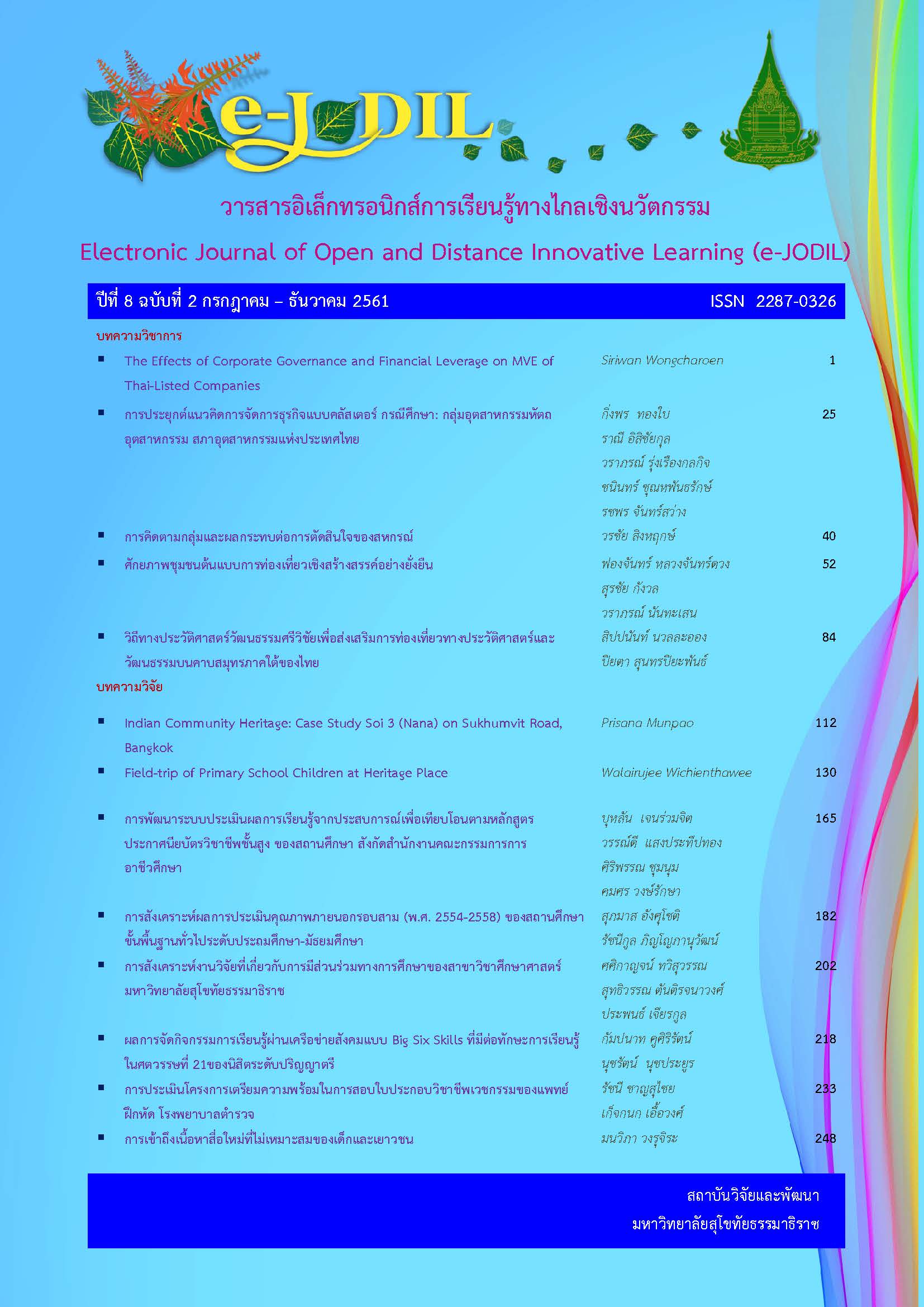Indian Community Heritage: Case Study Soi 3 (Nana) on Sukhumvit Road, Bangkok
Main Article Content
Abstract
This research studied background of Indians in Thailand, Nana community, Indian heritage and phenomena of present Nana. Nana precinct on Sukhumvit Road in Bangkok began as an Indian commercial community in tailor shops, Indian restaurants and mixed shops. Moreover, many Thai, Burmese and Thai – Lao people work in different careers e.g. street vendors, perfume shops and massage parlors. As tourists have continually changed from American servicemen in the Vietnam War era to mainly focus Middle-Eastern tourists. In addition, ASEAN people consisting of Chinese and Indian people have become tourists here. There are approached through five ways (1) Nana as spectacle in ambiguity of labels and Nana area’s disorder (2) Nana as a unity of diversity in dress, food, multi-languages and hotels (3) Nana as commodification (4) Nana as politic and economy (5) Nana as tourism in hedonistic and medical tourism
Downloads
Article Details
บทความ ข้อความ ภาพประกอบ ตารางประกอบ ที่ตีพิมพ์ในวารสารเป็นความคิดเห็นและความรับผิดชอบของผู้เขียนแต่เพียงผู้เดียว ไม่เกี่ยวข้องกับมหาวิทยาลัยสุโขทัยธรรมาธิราชแต่อย่างใด
บทความที่เสนอพิจารณาในวารสาร e-JODIL ต้องเป็นบทความที่ไม่เคยส่งไปลงพิมพ์ เผยแพร่ หรืออยู่ระหว่างการพิจารณาของวารสารอื่น
กองบรรณาธิการขอสงวนสิทธิ์ในการพิจารณาและตัดสินการตีพิมพ์บทความในวารสาร
References
paradoxes. Tourism Management, 32,(1),-15.
Baudrillard, Jean. (1985). Postmodern culture. London and Sydney: Pluto Press.
Bumrungrad Hospital. Retrieved June 21, 2017 from https://www.bumrungrad.com.
Clancy, M. (2002). The Globalization of Sex Tourism and Cuba: A Commodity Chains
Approach. Studies in Comparative International Development, 36(4), 63-88.
Clarke, J. and Critcher, C. (1985). The Devil Makes Work: Leisure in Capitalist Britain.
London: Macmillan.
Cohen, E. (1988). Authenticity and commoditization in tourism. Annals of Tourism
Research, 15 (3), 371–386.
Cohen, E. (2008). Medical Tourism in Thailand. AU – GSB e-Journal, 1(1), 24-37.
Cohen, E and Neal, M. (2012). A Middle Eastern Muslim Tourist enclave in Bangkok.
Tourism Geographies, An International Journal of Tourism Space, Place and
Environment, 14(4), 570-598.
Connell, J. (2005). Medical Tourism: The Newest of Niches. Tourism Recreation Research,
31(1), 99-102.
Edey, C. (2002). Bumrungrad Hospital: Five star Healthcare in Thailand. Thailand
Opportunities, 1(7), 76-78.
Evans, C. & Evans, L. (2009). Bangkok & Beyond: Adventures in Thailand. USA: Hunter
Publishing, Inc.
Google Map. (2017). Nana Area. Retrieved July 29, 2017 from https://www.google.co.th/
search?q=nana+area+bangkok&npsic=0.
Goossens, C. (2000). Tourism information and pleasure motivation. Annals of Tourism
Research, 27(2), 301-321.
Gotham, K. F. (2002). Marketing Mardi Gras: Commodification, Spectacle and the Political
Economy of Tourism in New Orleans. Urban Studies, 39(10), 1735–1756.
Gray, M. (2000). The political economy of tourism in North Africa: comparative perspective. Thunderbird International Business Review, 42(4), 393–408.
Gu, Z. (2004). Macau gaming: copying the Las Vegas style or creating a Macau model?.
Asian Pacific Journal of Tourism Research, 9(1), 89-96.
Hussain, Zakir. (1982). The Silent Minority: Indians in Thailand. Bangkok: Chulalongkorn
University Press.
Jafari, J. & Scott, N. (2014). Muslim world and its tourism. Annals of Tourism Research,
44, 1-19.
King, Ross. (2011). Reading Bangkok. Singapore: National University of Singapore.
King, Ross. (2017). An accidental Bangkok theme park. Tourism Geographies. USA:
Routledge Taylor & Francis Group.
King, Ross and Varavan, M.R. Pumin. (2017). Hidden Heritage (2): Sukhumvit 71. In:
Heritage and Identity in Contemporary Thailand. Singapore: NUS Press.
Leheny, D. (1995). A political economy of ASIAN sex tourism. Annals of Tourism
Research, 22(2), 367–384.
Liu, J. (2005). Tourism and the value of culture in regions. The Annals of Regional
Science, 39, 1-9.
Medina, L.K. (2003). Commoditizing Culture Tourism and Maya Identity. Annals of
Tourism Research, 30(2), 353–368.
Noree, T., Hanefeld, J., Smith, R. (2016). Medical tourism in Thailand: a cross – sectional
study. Bull World Health Organ, 94, 30-36.
Parsiyar, A. (2009). Medical tourism: the commodification of health care in Latin America.
Law and Business Review of the Americas, 15(2), 379-404.
Pielichaty, H. (2015). Festival space: gender, liminality and the carnivalesque.
International Journal of Event and Festival Management, 6(3), 235-250.
Poolthupya, Srisurang. (2008). Indians in Thailand. Rising India and Indian communities
in East Asia. Edited by Kwsavapany, K, Mani, A and Ramasamy, P. Singapore:
Institute of southeast Asian studies.
Porananond, P. (2015). Tourism and the transformation of ritual practice with sand
pagodas in Chiang Mai, Northern Thailand. Tourism Review, 70(3), 165–178.
Pornphol, P., Naveevong, C., Chittayasothorn, S. (2015). A Cloud- Based Management
informantion System for Medical and Wellness Tourism. International Journal
of Innovation, Management and Technology, 6(6), 378-382.
Rimmawi, H.S. and Ibrahim, A.A. (1992). Culture and Tourism in Saudi Arabia. Journal of
Cultural Geography, 12(2), 93-98.
Rojek, C. and Urry, J. (1997). Touring Cultures. London: Routledge.
Sandhu, K.S and Mani, A. (1993). Indian communities in Southeast Asia. Singapore: Times
Academic Press.
Sidhu, Manjit.S. (1993). Sikhs in Thailand. Bangkok: Chulalongkorn University.
Staiff, R & Bushell, R. (2003). Heritage interpretation and cross – cultural translation in an
age of global travel: some issues. Journal of Park & Leisure Management.
Sundstrom, M, Lundberg, C, Giannkis, S. (2011). Tourist Shopping motivation: go with the
flow or follow the plan. International Journal of Quality and Service Sciences,
3(2), 211–224.
Urry, J. (1990). The Tourist Gaze: Leisure and Travel in Contemporary Societies. London:
Sage.
Urry, J. (2002). The Tourist Gaze, 2nd ed. London: Sage.
Wang, U and Bramwell, B. (2012). Heritage protection and tourism development priorities
in Hangzhou, China: A political economy and governance perspective. Tourism
Management, 2012, 988-998.
Wong, I. A, McKercher, B, and Li, X. (2014). East Meets West Tourist Interest in Hybrid
Culture at Postcolonial Destination. Journal of Travel Research. 2014, 1-8.


